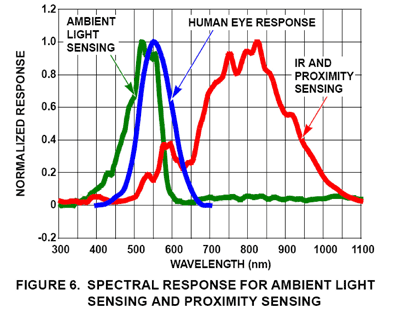Co-packaging the ambient light and proximity sensor
New consumer and commercial products benefit from
advanced sensor technologies
BY TAMARA SCHMITZ
Senior Principal Applications Engineer and Global Technical Training Coordinator
Intersil
www.intersil.com
Consumer devices like cell phones are using more and more sensors to save power and enhance our interaction with them. Some of the latest devices have multiple sensors; and now, two important and popular kinds of sensors – ambient light and proximity sensors are being co-packaged to save power, space, and cost. There are many good reasons for co-packaging, especially as an increasing number of everyday consumer electronics products and other systems can benefit from the combination of features the two kinds of sensors provide.
A couple quick definitions, first: An ambient light sensor acts like an eye for a system that measures the surrounding light, which can be either natural, like sunlight, or electrically generated lighting. Light emitting diodes (LED) measure and quantify the light, to enable a system to adjust its own display. If the surrounding light is bright, the backlight runs at full power; if darker, backlight drops and saves power.
The challenge is that silicon diodes naturally react to a wide spectrum of wavelengths. An ambient light sensor must be designed to mimic the human eye. This filtering is one of the quality measurements of the sensor, especially since the majority of light sources have energy in the infrared wavelengths (think about which light sources also give off heat). To demonstrate this filtering, see the plot in Fig. 1 . One example of a product with an excellent match of filtering in its ambient light sensor compared to the response of the human eye is the ISL29028A.

Fig. 1: Human eye response, ambient light sensor spectrum and proximity sensing spectrum of the ISL29028A.
We have to care about the wavelengths of the light, and also the intensity. For this discussion, it is helpful to understand the spectrum of light levels, called lux. This is shown in Figure 2. Full bright sunlight is often measured at 100,000 to 120,000 lux, an office may have 300-500 lux and candlelight is approximately 1 lux. Some light sensors are asked to cover this entire range or parts of it. Other light sensors are asked to go beyond the range.
| “Lux”: Measure of light density within the visible spectrum | |
| Direct sunlight | 100,000 to 130,000 lux |
| Full daylight | 10,000 to 20,000 lux |
| Cloudy day | 1,000 Lux |
| Office lights | 300 to 500 lux |
| Candlelight / dark | 10 to 15 lux |
Fig. 2: Table of lux values.
Recognize the range of the sensor you want to use. If your product won’t be typically used in direct sunlight, would it be enough to have a sensor that measures up to 2,000 or 8,000 lux? What does the sensor do when overwhelmed with direct sunlight, called saturation? There is an amount of time needed for recovery from overload; make sure your system can tolerate it.
At the other end of the spectrum is the precision monitoring of fractions of a lux. Many light sensors aren’t placed within view of the users, thus not it full view of the ambient light. Screens, obstructions, and tinted glass will reduce the amount of light that reaches the sensor and require that it measure fractions of lux.
The rise of proximity sensors
Another important kind of sensor is now making major waves in a bunch of markets including consumer electronics. That is the proximity sensor, which is designed to measure an infrared signal. It’s different from an ambient light sensor because the signal comes not from the surrounding area, but from an external infrared LED (diode) located near the sensors.
The signal from this LED is directed out above the proximity sensor and if a person or object enters the path of the infrared emission, there will be a reflection back to the sensor. Interestingly, the sensor is also composed of an LED. This allows a system to react to someone or something coming close since the reflected light will grow brighter. Then, some kind of action can follow, including dimming.
In the case of a cell phone screen that comes close to a user’s face, a threshold is chosen where the sensor can turn the screen off so there will be no mistaken selections on the touchscreen or buttons from contact with the cheek. This is a good idea for saving power and for reducing call mishaps.
A proximity sensor can even be attached to robots in factories or laboratories to ensure that the robots don’t run into walls or doors. In another example, they can be attached to specific locations on vehicles such as cars, trucks or even airplanes to be sure drivers get signals when they’re coming close to any kind of stationary or moving object. This kind of accident-preventing sensor is already in use in many commercial applications. Note that different measurement distances use different methods of proximity detection. We will limit our discussion to infrared (IR) systems.
Advantages of co-packaging
The major breakthrough now is integrating ambient light and IR proximity sensors. The two separate systems can be supplied in one package to deliver some significant advantages.
Let’s consider how the combined ambient light and proximity sensor work. While they are two separate systems, they can both be categorized as optical systems using a sensing LED. Each collects information from the outside world, quantifies it, and provides it to the system. Currently, the system predominantly uses the information to adjust the display’s backlight; it’s a short step to expand the whole process to control more system features.
Of course, it is convenient to save space, to share supplies, and to combine power supply bypassing. The size of the solution is a critical parameter in many systems, especially portable ones. The co-packaging of the proximity sensor and ambient light sensor is an enabling step in the development of more compact, yet feature enhanced, cell phones.
The next reason is location. Both the proximity sensor and ambient light sensor need access to the outside world to function, so they must be placed within a system according to their sensitivity and their correct operation. In some cases where an ambient light sensor is packaged alone, it has been placed deeper within a system—behind a speaker screen or further down a printed circuit board from a nearby external access point. This practice has pushed ambient light sensors to be more and more sensitive to this indirect light. Light intensity is measured in lux. While sunlight exceeds 100,000 lux, these ambient light sensors can detect 0.002 lux! That’s a tiny fraction of a candle’s light.
A final and compelling reason to house the proximity sensor and ambient light sensor in the same package is that it enables quick and undisturbed communication between the two. Remember in the beginning during the explanation of the operation of the ambient light sensor that we explained how its sensor must mimic the human eye. The human eye does not see infrared light, so the ambient light sensor is specifically designed to remove as much energy in the infrared wavelengths as possible. The proximity sensor operates precisely within the infrared spectrum and whenever it attempts to make a measurement, it is simultaneously sending out infrared light in the hope of bouncing off of a nearby object. This infrared energy could hurt the ambient light sensor’s input and cause false positive measurements, an instance in which the ambient light sensor measures more light energy than is actually in the surrounding area. So it’s vital to coordinate the operation of the ambient light sensor with the proximity sensor. This can be accomplished with a microcontroller, but it’s easier and a much smaller footprint to have this coordination within a single package. The package houses both the ambient light sensor and the proximity sensor, providing several benefits.
For instance, both sensors enable power savings by dimming or shutting down the backlight and interface with the same system blocks. Co-packaging saves space and reduces complexity. Both sensors need access to the outside of the system and would likely be located in similar places. And since interference from the proximity sensor system can disturb the ambient light sensor, coordination between these two features is paramount.
For all of these reasons, there is a huge advantage in co-packaging the proximity sensor and ambient light sensor. ■
Advertisement
Learn more about Intersil





